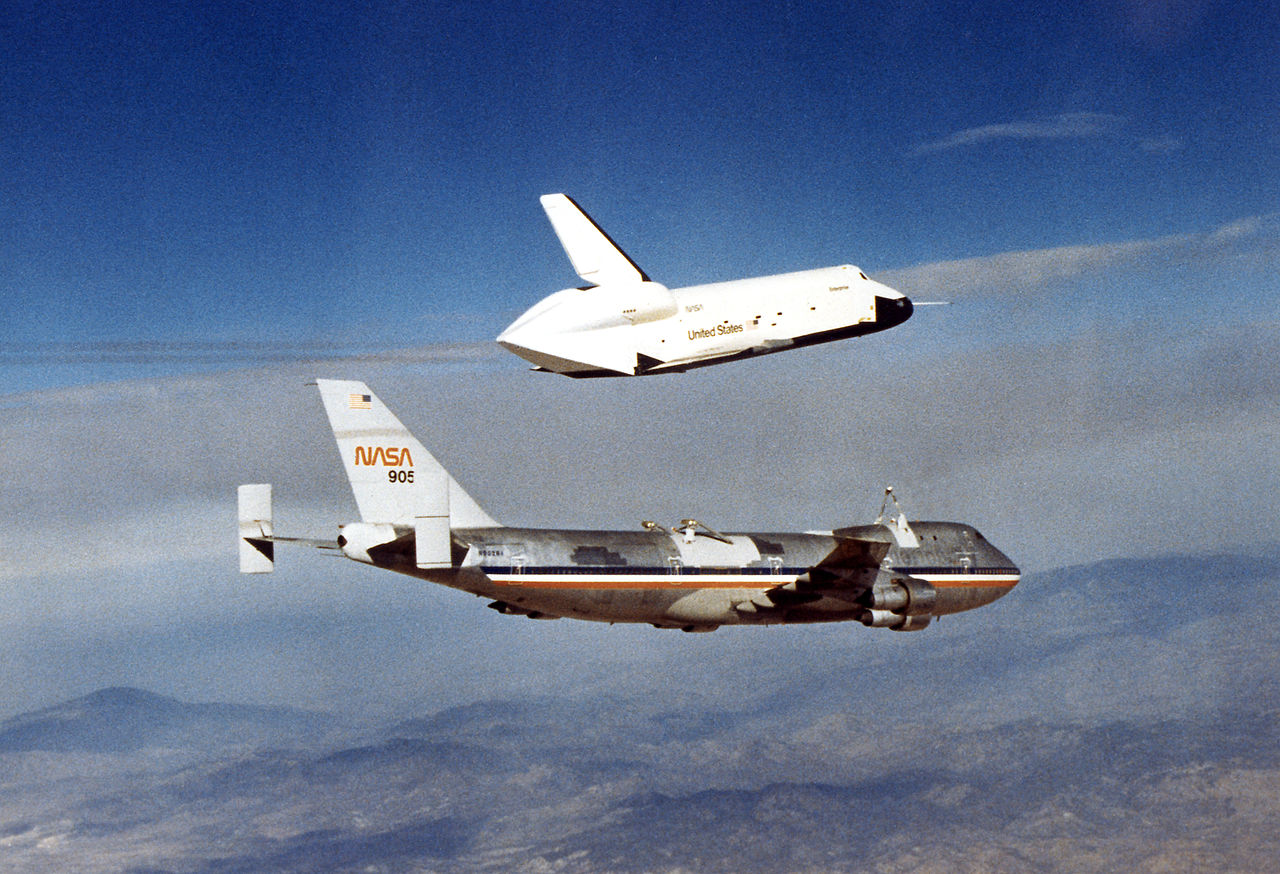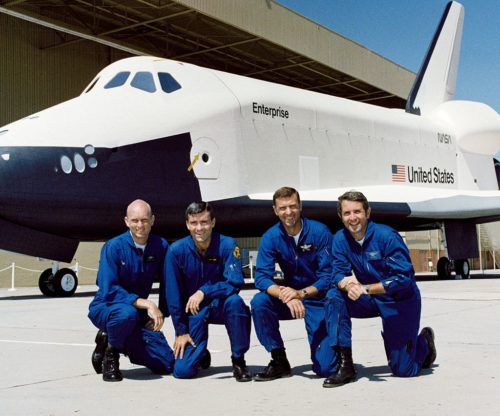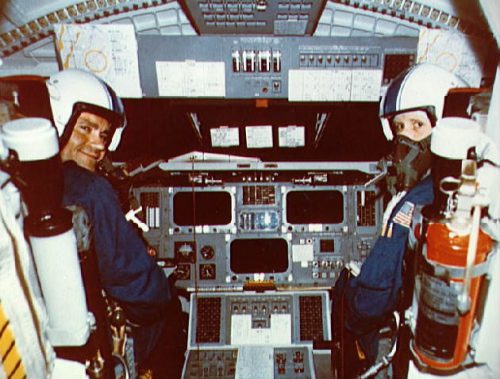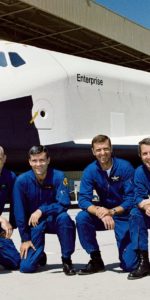
The Approach and Landing Test (ALT) series of the Space Shuttle, which began 40 years ago, in the summer of 1977, were “just that”, in the words of NASA astronaut Joe Engle. Their goal was to deliver Orbiter Vehicle (OV)-101, nicknamed “Enterprise”, to an altitude of 25,000 feet (7,600 meters), atop a heavily modified Boeing 747 Shuttle Carrier Aircraft (SCA), above Edwards Air Force Base, Calif. Engle and fellow astronauts Fred Haise, Dick Truly and Gordon Fullerton, would place Enterprise—a near-identical version of the orbiters which would someday launch 135 times from Earth—into aerodynamic flight, exercising its hydraulic, electronic, flight-control and landing systems in conditions as close as possible to those the real Space Shuttle would experience during its descent and landing.
The overall goal, Engle reflected in a NASA oral history interview, was to gather as much data from Enterprise as possible, as far as stability and control and performance were concerned. “In other words, not have to worry about coming in to land and the wind coming up and giving you a big crosswind or low clouds or things like that,” he said. “You could take off and, an hour later, drop, and you knew what the weather was going to be.” The ALT series was aided by the fact that the shuttle as an aircraft was ready before its troublesome Space Shuttle Main Engines (SSMEs) were ready. “That gave NASA an opportunity to get a look at the orbiter vehicle, its basic configuration, its flight control system, and make sure that it had an airplane or vehicle that could fly the pattern, the approach, the flare and the landing,” said Engle. This portion of the flight, he admitted, was “a very, very small part of its mission, but a very, very critical part of its mission”.
As outlined in yesterday’s AmericaSpace history article, the four astronauts—working in two teams; Haise partnered with Fullerton and Engle with Truly—spent many months, from October 1976, working in the Orbiter Aeroflight Simulator and Shuttle Procedures Simulator at NASA’s Johnson Space Center (JSC) in Houston, Texas, as well as flying T-38A Talon jets and the heavily modified Grumman Gulfstream II Shuttle Training Aircraft (STA).

For her test flights, Enterprise would be secured atop the mammoth Boeing 747 and carried to an altitude of 25,000 feet (7,600 meters). First would come a series of “Captive-Active” flights, designed to validate the shuttle’s aerodynamics and flight control surfaces, whilst still attached to the SCA. Successful completion of this phase would allow for a series of Free Flights, in which Enterprise would detach from the jumbo and glide to an unpowered, “deadstick” landing at Edwards.
The first Captive-Active test was originally scheduled for 9 June 1977, but was postponed by several days when engineers discovered a leaking fuel pump seal in one of the shuttle’s Auxiliary Power Units. The APU was replaced and tested and the flight was rescheduled for the 17th. Another 24-hour delay was enforced when one of Enterprise’s computers exhibited a fault and was replaced. At 8:06 a.m. PDT on 18 June, 585,000-pound (265,350 kg) SCA/shuttle combo—which one aerospace journalist dubbed “the world’s largest biplane”—lumbered off the runway and was airborne. Aboard the Boeing were pilots Fitz Fulton and Tom McMurtry, together with flight engineers Vic Horton and Louis “Skip” Guidry, whilst Enterprise’s crew consisted of Commander Fred Haise and Pilot Gordon Fullerton.
It was a peculiar sensation, sitting aboard the shuttle’s flight deck at such great height above the runway. “When we first rode on top,” Haise recalled in a NASA oral history interview, “you couldn’t see the 747, no matter how [much] you’d try to lean over and try to look out the side windows. Not even a wingtip! It was kind of like a magic carpet ride. You’re just moving along the ground and you take off; and something below you [was carrying you]; you knew it was there, but you couldn’t see what was taking you aloft. It was also deceptive sitting up that high. Things always looked like it was going slower than it was, for your taxiing and particularly the first takeoff. I really thought Fitz had rotated too early. It didn’t look like we were going fast enough.”
The feeling of nervous excitement was equally intense for the crew of the Boeing. “Fitz was a great leader,” McMurtry recalled years later, citing the quiet moment, seconds before taxiing for takeoff on 18 June, when Fulton turned and shook hands with him, Horton and Guidry. “I thought that was a nice gesture. I think he just wanted to do that as a friend.” During this 56-minute flight, Haise and Fullerton were able to briefly test Enterprise’s aerosurfaces, rudder and speedbrake.
Ten days later, on 28 June, Commander Joe Engle and Pilot Dick Truly set off for a second Captive-Active flight, lasting 63 minutes and attaining an altitude of 20,600 feet (6,280 meters). This flight afforded low-speed testing of Enterprise’s control systems and simulating the separation maneuver from the SCA which would characterize the Free Flights from August 1977 onwards. Fulton climbed to altitude, then pushed-over and descended at around 3,000 feet (900 meters) per minute, thereby enabling Engle and Truly to position the shuttle’s elevons in their primed-to-separate configuration.
Haise and Fullerton closed out the three-flight Captive-Active roster on 26 July, finalizing avionics and control surface checks, ahead of the Free Flights. The only glitch was a faulty sensor in one of Enterprise’s auxiliary power units, which triggered a caution-and-warning alarm in the cockpit and obliged Fullerton to shut it down. After landing on concrete Runway 22 at Edwards, Haise was able to deploy the shuttle’s landing gear—whilst still atop the Boeing—in readiness for the free flights.

In retrospect, the Captive-Active tests demanded close co-ordination between the astronauts aboard Enterprise and Fulton’s crew aboard the SCA. “Our main concern was to develop a separation maneuver with Fitz Fulton to optimize the separation between the two vehicles, both vertically and laterally,” recalled Engle. “Fitz would put the combination in a slight dive to get the right airspeed in level flight. He would “dive” the airplane and when he got on speed, he would call.
“We would separate and at that time the orbiter was sitting with a 15-degree angle of incidence; in other words, 15 degrees angle of attack and was trying to fly off the 747 at that time. Fitz would dump lift on the 747, throttle back to idle, so that as we came off, we didn’t slide back and take his tail off; then the two of us would turn in different directions as well, so that as soon as we lost energy and started to come back down, we didn’t come back down on top of him. In looking at the videos, there was lots of room, lots of separation, but initially we weren’t sure, so we optimized everything we could.
“We didn’t compromise anything by doing that, but we did have plenty of room for separation, and it was a co-ordinated maneuver. We would pull off to the right; he’d dive off to the left, then we’d go wings level and go right into the data-gathering maneuvers, because we had very little time to get data. We had about a minute and a half to get data and then, well, the rest of the time was flare and land, to get the gear down and touch down.”
With the Captive-Active missions completed, Haise, Fullerton, Engle and Truly were primed for a series of Free Flights from August 1977. The success of the ALT series played a significant role in enabling the maiden voyage of Space Shuttle Columbia in April 1981.
Be sure to “LIKE” AmericaSpace on Facebook and follow us on Instagram & Twitter!





